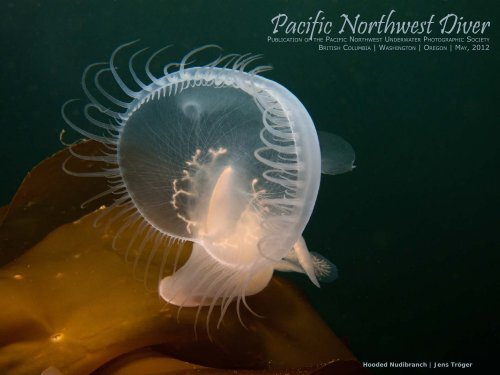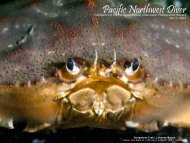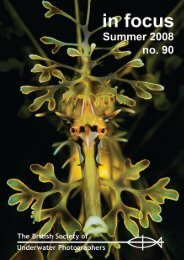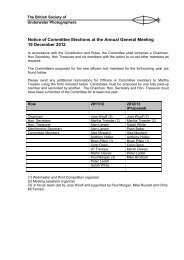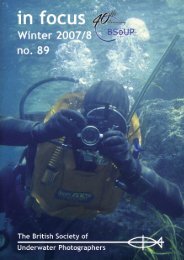Pacific Northwest Diver - British Society of Underwater Photographers
Pacific Northwest Diver - British Society of Underwater Photographers
Pacific Northwest Diver - British Society of Underwater Photographers
- No tags were found...
Create successful ePaper yourself
Turn your PDF publications into a flip-book with our unique Google optimized e-Paper software.
<strong>Pacific</strong> <strong>Northwest</strong> <strong>Diver</strong>BI-MONTHLY MAGAZINE & WEB SITE PROMOTING UNDERWATER PHOTOGRAPHY, EDUCATION, & TRAVEL IN THE PACIFIC NORTHWEST | MAY, 2012In this Issue 3Hornby Island to Portland 3Subscribing to <strong>Pacific</strong> <strong>Northwest</strong> <strong>Diver</strong> 3From the Archives: First <strong>Underwater</strong> Color Photo, 1917 3Featured Photographer: Jens Tröger 4News Corner 8<strong>Underwater</strong> Sports Photo Contest 8Fukushima Ocean Radiation Plume 8<strong>Underwater</strong> Photo Workshops 8Feartured Operator/Resort: Hornby Island Diving 9<strong>Photographers</strong> & Videographers 12<strong>British</strong> Columbia: Roy Mulder 12Washington: Dennis Howie 14Oregon: Laura Tesler 15Dive Travel Corner 16Grand Bahama Island: Dolphins, Sharks, & Cavern 16La Paz: Whale Sharks, Sea Lions, & Hammerheads 16Nautilus Swell with Virginia & Andy Lamb 16Technical Corner 17First Looks at Lightroom 4, Photoshop CS6 17Samsung Waterpro<strong>of</strong> SD Cards 17PNW <strong>Diver</strong> Team 18iPhone Users: Your PDF viewer does not support active links. To view video and use other links, we suggest the ap Goodreader .Page 2
<strong>Pacific</strong> <strong>Northwest</strong> <strong>Diver</strong>: In This IssueWelcome to Spring in the <strong>Pacific</strong> <strong>Northwest</strong> and the May issue <strong>of</strong> <strong>Pacific</strong> <strong>Northwest</strong> <strong>Diver</strong>! This edition features divers, photographers, and videographersfrom Hornby Island, to Vancouver, to Anacortes, Redmond, and Portland. There is also an initial look at Adobe’s Lightroom 4, Photoshop CS6, and CreativeCloud. Samsung has also brought waterpro<strong>of</strong> SD and mini-SD storage units to market. In the News Corner there is preliminary information about UnderaterSports <strong>Diver</strong>s’ Fair photo contest, an interesting look at the Fukushima ocean radiation plume, and underwater workshops. And from the archives, thefirst underwater color photo and amazing way light was provided.In this Issue:Hornby Island to PortlandTo Subscribe:PNWUPS Free MembershipFrom the Archives:First <strong>Underwater</strong> Color Photograph: 1917Hornby Island DivingRoy MulderDennis HowieJens TrögerLaura Tesler<strong>Pacific</strong> <strong>Northwest</strong> <strong>Diver</strong> is a publication <strong>of</strong> the <strong>Pacific</strong><strong>Northwest</strong> <strong>Underwater</strong> Photographic <strong>Society</strong> (PNWUPS).In order to subscribe to this e-publication, please completethe Subscribe fields on the PNWUPS home page.Membership is free, and e-mail addresses are not sharedwith other groups or businesses. We need an accuratecount <strong>of</strong> subscribers to assist with sponsorships andtravel.We are all over-loaded with e-mail, tweets, etc, so communicationfrom <strong>Pacific</strong> <strong>Northwest</strong> <strong>Diver</strong> and PNWUPS willbe limited to one or two e-mails per month, at most.If you are interested in trips with other underwaterphotographers and videographers, please check out theTravel Section on page 16. In 2012 we will be photographingdolphins, sharks, and caverns in the Bahamas;whale sharks, sea lions, and hammerheads in La Paz; plusVirginia and Andy Lamb are leading a group on NautilusSwell in October.If you have any questions about subscribing, please contactpublisher Dan Clements.<strong>Underwater</strong> color photography began with this shot <strong>of</strong> ahogfish, photographed <strong>of</strong>f the Florida Keys in the Gulf <strong>of</strong>Mexico by Dr. William Longley in 1917.Equipped with cameras encased in waterpro<strong>of</strong> housing andpounds <strong>of</strong> highly explosive magnesium flash powder forunderwater illumination, the pair pioneered underwaterphotography.Longly used a 4 x 5 camera in a watertight housing fittedwith controls for all the adjustments needed. They werepublished ten years later along with those <strong>of</strong> CharlesMartin, in January 1927 in National Geographic Magazineunder the title “The first autochromes from the ocean bottom”.What was unique about their “flash”was that it was placed on the surface,ignited, and lit up the water below.The hogfish photo was taken at adepth <strong>of</strong> about fifteen feet.Lighting and strobes have certainlyevolved. Contrast the size and danger<strong>of</strong> this approach as opposed to charginga one <strong>of</strong> the new compact Light inMotion lights!Page 3
<strong>Pacific</strong> <strong>Northwest</strong> <strong>Diver</strong>: Featuring Jens TrögerNo, no Jens. That’s notwhat Marc meant bywatch out!Marc’s “dive nerd”friens are Marc, Bernie,and Tom (see March,2012 issue).Jens TrögerJens was Scuba certified in 1999 in an ice coveredflooded quarry in East Germany, and things got onlybetter from there!After school in Australia he moved to the <strong>Northwest</strong>in 2005, and has lived and dived here ever since.Having traveled and dived all over the world, hestill likes the <strong>of</strong>ten unspoiled and cold waters <strong>of</strong> the<strong>Northwest</strong> that are teeming with life.Too <strong>of</strong>ten Jens takes his camera out and, togetherwith equally obsessed dive nerds, travels the <strong>Northwest</strong>in pursuit <strong>of</strong> good dives and photographs. Onoccasion, Jens also works as a dive instructor.He holds a PhD in computer science and is a seniorengineer and technical lead with Intel.EquipmentJens started out with a point-and-shoot Sony Cybershotmany years ago, but soon that didn’t quite do itanymore. Then came a Canon G10, Fix housing, withtwo YS-110a strobes, but soon that didn’t quite do itanymore.Today, Jens shoots with a Canon 7D in a Nauticamhousing and YS-120 strobes. For macro he uses aCanon 100mm lens with a SubSee 10x diopter, andfor wide angle shots the Tokina 10-17mm lens.Post processing is done in Camera Raw and Photoshop,but even the magic <strong>of</strong> Photoshop can’t turn amediocre shot into a good image, and so the mainwork remains to take a good picture in the firstplace.Shooting Macro & Super MacroHere are Jens’ thoughts on shooting macro andsuper-macro.It takes several ingredients to compose a shotthat I like which, most <strong>of</strong> the time, is a colorfuland simple image. I can’t really control all <strong>of</strong> theseingredients like visibility or finding an interestingsubject with good negative space (background).But there are heaps <strong>of</strong> opportunities here in the<strong>Northwest</strong> to shoot macro, and after the initialexcitement where I’d fire away at every critter Icame across I soon realized that a good picturefirst takes a bit <strong>of</strong> luck, and then a lot <strong>of</strong> care.And so, once I find something interesting <strong>of</strong> suitablesize, I first spend a little time watching thecritter in order to get a feel for what it’s actuallydoing, where it’s moving. I also observe it fromdifferent angles to figure out how to make a picturemore interesting. This initial sniffing out alsohelps me to check on current conditions, ambientlight, and the quality <strong>of</strong> suspended particles. Most<strong>of</strong> the time I’m looking for a simple backgroundthat doesn’t distract with color or texture, so thatI can either use the green water as a background,or rocks, kelp, sand.The next thing is camera positioning. I <strong>of</strong>ten foundthat getting the camera in and close at the rightangle can be tricky. Positioning the strobe(s) forthe right lighting takes equal consideration, andsometimes, well, it just doesn’t work if there’s rockor corals in the way. When the camera is somewhatin place, and considering the Rule <strong>of</strong> Thirds, Itry to shoot straight onto my critter, or even frombelow up to give it depth and to make it look moreinteresting in its own context. A shot from atop <strong>of</strong>a small critter <strong>of</strong>ten seems flat, with little depth.To stabilize the camera I use one hand to rest thecamera on, holding on to a rock or the bottom.The first shot is <strong>of</strong>ten more <strong>of</strong> a test shot, to finetuneaperture and shutter speed, strobe positioningand strength, and maybe to change the angle.Now that my camera allows for it, I switch it toServo Auto Focus so that I can track a moving critteror compensate for my own movements. This isespecially handy for super-macro shots, where thedepth-<strong>of</strong>-field is only a few millimeters and wherethe critter itself isn’t much larger than that either.I always focus on the eye, or the head sectionright between the oral tentacles <strong>of</strong> a nudibranch,as this is the most interesting part. Then, oh theexcitement, I press the shutter!If the critter is patient enough with me, then Iexperiment. I take different shots with differentdepths <strong>of</strong> field, and from different angles. It happenedin the past that one image that I was happywith during a dive, looked rather boring on the bigscreen, but another that I had almost dismissedearlier, came out great. These are the opportunitieswhen I can really learn and practice my gear,and can compose the image the way I like it.That’s the first but also most important part <strong>of</strong>getting a picture which may make it onto my walleventually. The next thing is to “develop” the rawimage data from the camera into the actual print.The general workflow is quite the similar everytime, although I do spend a little time tweakingsome details on occasion. Adobe’s Camera Rawtool is my first choice to crop and straighten theimage, adjust the white balance, and to maybelevel out some exposure dissonances. At this pointI don’t saturate or sharpen the image yet, butinstead pull it into Photoshop.First thing there is to remove some <strong>of</strong> the distractingbackscatter; however, if there’s too much <strong>of</strong> it,then the picture just won’t do it. After this initialclean-up, I continue working in LAB mode instead<strong>of</strong> RGB, because in LAB I can separate color fromlighting information. Sharpening is quite essentialin image processing workflow, and by sharpeningonly the lighting channel in LAB mode I avoid colorsaturations like they may happen in RGB sharpening.A little more contrast, a little more color,and then that’s all there’s really to it! Personally,if I find myself spending too much time tweakingan image for to long, then it may just be timeto abandon that image and shoot again in betterconditions.In the end though, with all this effort and moneyspent on gear, tinkering with settings, noodlingthrough s<strong>of</strong>tware, I’m having heaps <strong>of</strong> fun with all<strong>of</strong> this. And that is, I think, the most importantingredient <strong>of</strong> all.Thanks for sharing your work with us!Web: http://savage.light-speed.de/e-Mail: jens.troeger@light-speed.dePage 4
<strong>Pacific</strong> <strong>Northwest</strong> <strong>Diver</strong>: Jens Tröger, continuedScaly Head SculpinCanon G10, 1/400, f/4.5, ISO 100, 25mm,Page 5
<strong>Pacific</strong> <strong>Northwest</strong> <strong>Diver</strong>: Jens Tröger, continuedOpalescent NudibranchCanon G10, 1/320, f/4, ISO 400, 18mmPage 6
<strong>Pacific</strong> <strong>Northwest</strong> <strong>Diver</strong>: Jens Tröger, continuedDecorator CrabCanon 7D, 1/125, f/13, ISO 200, 100mmPage 7
<strong>Pacific</strong> <strong>Northwest</strong> <strong>Diver</strong>: News Corner<strong>Diver</strong>s’ Fair: July 27-29<strong>Diver</strong>s’ Fair Photo Contest<strong>Underwater</strong> Sports in Seattle will be hosting the 34th annual<strong>Diver</strong>s’ Fair on July 27, 28, and 29. As part <strong>of</strong> this eventthere is an underwater photo contest, so get those printsready!How to EnterThere is an entrance fee <strong>of</strong> $6.00 for each photo submitted,and there are two categories with two prizes.Photo CategoriesThe two contest categories are Tropical and <strong>Pacific</strong> <strong>Northwest</strong>.As mentioned above, there are first and second placeprizes in both categories.Last year’s winners were Martin Heyn winning both tropicalplaces, Dimitry Kholodkov first place <strong>Pacific</strong> <strong>Northwest</strong>photo, and Daniel Hershman second place in the <strong>Pacific</strong><strong>Northwest</strong> category.Summary <strong>of</strong> RulesThis is a “print” only contest. The other main requirementis that, to be eligible to win, photos must be framed and/ormatted. Framing is preferred.Additional information and prizes will be posted on <strong>Underwater</strong>Sports <strong>Diver</strong>s’ Fair web page shortly. If you have questions,feel free to contact the staff at <strong>Underwater</strong> Sports at206.362.3310, or by e-mail at uws@underwatersports.com.Good Luck!Fukushima Ocean Radiation Plume- Click on Image to Play Video -ASR, a global coastal and marine consulting firm, has developeda model <strong>of</strong> radiation dispersal from the Fukushimanuclear plants that were heavily damaged in March, 2011.The model uses a Lagrangian particles dispersal methodto track where free floating material (fish larvae, algae,phytoplankton, zooplankton...) present in the sea waternear the damaged Fukushima Daiichi nuclear power stationplant could have gone since the earthquake and Tsunami onMarch 11th.It is also interesting to note that Fukushima continues toleak radioactive contaminates into the <strong>Pacific</strong>. The ASRmodel assumes that a part <strong>of</strong> the passive biomass couldhave been contaminated in the area, they are trying to trackwhere the radionuclides are spreading as it climbs up thefood chain.This past August the Canadian Food Inspection Agencyannounced it had begun checking sockeye salmon for anysigns <strong>of</strong> radiation, and a few days ago the Washington StateDepartment <strong>of</strong> Fish and Wildlife announced that they hadbegun testing salmon and clams for radiation.The major concern to those <strong>of</strong> us in the <strong>Pacific</strong> <strong>Northwest</strong> isthe health threat posed by cesium-137, which has a halflife<strong>of</strong> 30 years. Cesium-137 still contaminated land aroundthe site <strong>of</strong> the 1986 Chernobyl nuclear disaster. Cesium-137mixes easily with water and is chemically similar to potassium.It mimics how potassium is metabolized, and can enterthrough many foods.<strong>Underwater</strong> Photo/Video WorkshopsLooking to improve your underwater photography or videography?We have tried to list some <strong>of</strong> the top workshopstaught by some <strong>of</strong> the top underwater photographers.Stephen FrinkWaterhouse Tours6-9/6-16 Digital Master, Key Largo7-7/7-14 Digital Master, Bonaire7-14/7-21 Digital Master, BonaireInstructors also include Photoshopguru Eddie Tapp and DSLR videoexpert Frazier Nivens.Several <strong>of</strong> us have taken Stephen’sworkshops, and they were outstanding.Dr Alex Mustardamustard.com6-16/6-23 <strong>Underwater</strong> WorkshopRed Sea, Egypt on MY Whirlwind6-23/6-30 <strong>Underwater</strong> WorkshopRed Sea, Egypt on MY WhirlwindLocal members have taken Alex’sDigital Madness class and found itexcellent. Less emphasis on postprocessing and more on shooting.Berkley White & OthersBackscatter6-16/6-23 Digital Shootout,Little Cayman9-17/9-17 Backscatter WakatobiLembeh Resort, IndonesiaBackscatter runs dozens <strong>of</strong> trainingevents all over the globe eachyear. Check their website for detailson the program and instructorsfor each event. Don’t let “MadScientist” Berkley frighten you!If you would like a review <strong>of</strong> any <strong>of</strong> these workshops,please contact Jim Boon or Dan Clements. These workshopsare outstanding ways <strong>of</strong> improving your photo,video, and post-processing skills!Page 8
<strong>Pacific</strong> <strong>Northwest</strong> <strong>Diver</strong>: Operator Corner- Hornby Island DivingHornby Island Diving is celebrating is 40th birthday this year! Founded by Bob and Ann Zielinski in 1972, his son and daughter-in-law Rob and Amanda arethe current owners. Hornby Island is located about an hour’s drive, and two short ferry rides, north <strong>of</strong> Nanaimo. It is reached by driving to Buckley Bay,taking a ten minute ferry ride to Denmann Island, followed by another short ferry ride to Hornby Island. Beautiful setting, quality dive operation!Rob and Amanda Zielinski are the ownersand operators <strong>of</strong> Hornby Island Diving. Theyare full-time residents <strong>of</strong> Hornby Island, aswell as avid divers. They look forward tointroducing you to their “back yard.”The dive boat is excellent for photographersand divers: a welded aluminum hull andsuperstructure, 35’ length, with a 10’6”beam. Forward cab and covered area are forprotection from the elements.- Hornby Island DivingHornby Island Diving is a family run businessthat has been in operation for fourtyyears. It was started by Robert (Bob) Zielinski,a dedicated and experienced diver whoextensively explored the <strong>British</strong> Columbiacoast with his wife Ann, before settling onHornby in 1972.Although equipment and amenities weren’tas comfortable as they are today, divingwas growing in popularity in BC, and peoplewere looking for a place to dive and relaxfor a few days. Hornby Island Diving is one<strong>of</strong> the original SCUBA charter operations onthe BC coast. Bob passed on the businessin 1996. It is now operated by his son, Roband Rob’s wife Amanda.Over the years Hornby Island Diving hasprovided guiding and expertise to variousprojects such as television documentaries,books, magazines and research.The Zielinski family has long been concernedwith marine conservation, and theirefforts contributed to the designation <strong>of</strong> themarine component <strong>of</strong> Helliwell ProvincialPark. This area is closed to the taking <strong>of</strong>marine life by divers, and is currently underconsideration for further protection, due toits significant populations <strong>of</strong> bottom fish andinvertebrates.The tank rack accommodates any size tank,twin tanks or rebreathers. There is a swingingdoor and stable ladder placed forwardfor easy entries and exits, away from motors,along with a grab rail at water level.And the subject matter for photographers?November to February - great visibility, sealions; March - herring spawn, an incrediblewildlife event; April/May - wonderful springdiving with baby jellies, nudibranchs, crabs,fish and more; May to September - sixgillsharks; and September/October - best visibility,a great time for wall dives.- Rob & Amanda ZielinskiWeb: http://www.hornbyislanddiving.com/e-Mail: info@hornbyislanddiving.comPhone: 250.335.2807Dining AreaView Up-StairsPage 9
<strong>Pacific</strong> <strong>Northwest</strong> <strong>Diver</strong> Operator/Resort Corner, continued- Rob with Giant <strong>Pacific</strong> OctopusPage 10
<strong>Pacific</strong> <strong>Northwest</strong> <strong>Diver</strong> Operator/Resort Corner, continuedWorld <strong>of</strong> Color and Life on Hornby Island!- Cavorting Sea Lions- Northerm Abalone- Swimming Anemone- Painted GreenlingPage 11
<strong>Pacific</strong> <strong>Northwest</strong> <strong>Diver</strong>: <strong>British</strong> ColumbiaRoy MulderRoy has been diving for 37 years,alongside a lifetime <strong>of</strong> photographyand video. Additionally, Roy has sat onboards <strong>of</strong> several not-for-pr<strong>of</strong>it organizations.He currently owns UWVIDEO1,which produces high quality video andphotos for a variety <strong>of</strong> companies andnot-for-pr<strong>of</strong>it organizations. He is alsocurrently President <strong>of</strong> Marine Life Sanctuaries<strong>Society</strong> <strong>of</strong> BC.He was given his first camera at theripe age <strong>of</strong> 6, printed his first photo at10, and became one <strong>of</strong> the youngestmembers <strong>of</strong> the London Camera Clubat 13. His fascination and interest innature helped molded his views aboutour place on the planet. Roy recognizedearly on that the ability to create visualimagery would help “grab” lay interestin a subject.Although Roy is an accomplished stillphotographer, he believes that video isa more effective tool in creating retentionon a subject or product. His earlydays learning to be an Audio VisualTechnician helped prepare him for thevideos and images he now produces,even though equipment and processinghave advanced dramatically.He is a past Board Chair <strong>of</strong> the TD/Canada Trust Friends <strong>of</strong> the EnvironmentFoundation Vancouver Chapter.Web: http://uwvideo1.webs.com/e-Mail: rsmulder@shaw.ca- Click on Image to Play Video -This promotional video for Oceanic Nurseries is a fine example <strong>of</strong> Roy’s videowork, and seeking collaboration to help resolve our depleated fisheries issue.- Click on Image to Play Video -The Canadian Coast Guard ship Ready lies on the bottom in Brittania. ColinParkinson gives a narration <strong>of</strong> life aboard in years gone by.Page 12River otter Roy was filming (photo upper left) as it was beingtaught to swim!Sea lion doing its best imitation <strong>of</strong> an Antarctic leopard seal a laPaul Nicklin.
<strong>Pacific</strong> <strong>Northwest</strong> <strong>Diver</strong>: <strong>British</strong> Columbia, continued- Click on Image to Play Video -This video is the Howe Sound Report for Sunday November 27, 2011. Prawning is legal in rockfish conservation areas and become killing machines when they come loose from their buoylines. The video shows two traps being recovered. This is why Marine Life Sanctuaries <strong>Society</strong> is promoting voluntary full no-take marine sanctuaries in all Rockfish Conservation Areas.Page 13
<strong>Pacific</strong> <strong>Northwest</strong> <strong>Diver</strong>: WashingtonDennis HowieWelcome to the world <strong>of</strong> the purist!Dennis and his wife Tracy are free divers.Yes, you’ve got it: to take shotsDennis holds his breath, follows subjects,then shoots.- Sunlight Reflecting <strong>of</strong>f Water and Pilings, 24 MM, 1/80th, f 13, ISO 200 - Sea Star & Mertridium on Piling, 24 MM, 1/80th, f 4.5, ISO 200Everytime I see him in the water I amamazed. SCUBA divers are referred toas “Bubble Blowers.”He has been freediving since childhood, and taking underwaterphotos for five years.His gear consists <strong>of</strong> a Nikon D-90,Tokina 10-17, and Nikon 12-24. Hishousing is an Aquatica fitted for anothercamera, so he has to present hissettings before entering the water.Usually settings are shutter priority,with the Tokina out to 17 MM, and theNikon lens to 24 MM.Since Dennis is also not using strobes,he has spent much time working withambient light. On dark days and atdepth he will use his dive light to helplight up a subject.He is frequently found at Keystone,which is a short trip from his Anacorteshome. For post-processing Dennis usesa Windows based platform with AdobeLightroom.Web: Portfolio on Facebooke-Mail: tracyanddennishowie@yahoo.com- Ling Cod Hiding in the Kelp, 24 MM, 1/80th, f 4, ISO 450Page 14
<strong>Pacific</strong> <strong>Northwest</strong> <strong>Diver</strong>: OregonHer appetite was whetted for more,especially with wide angle lenses. Shestarted to save her pennies.In October 2011 Laura decided to buyherself a nice birthday present, and forcost reasons started researching thenew 3/4 mirrorless systems, which arealso billed as a “step above the pointand shoot” and the entry level DSLRcamera lineup.Laura TeslerShe liked that these systems could acceptinterchangeable lenses and ports:you were not stuck with the samelens like a Canon G10 or G11. Sheresearched the Olympus brand whichwas the fist 3/4 mirrorless out on themarket outside <strong>of</strong> Leica.Laura has been taking photographssince she was 10. She is a fisheriesbiologist with the Oregon Department<strong>of</strong> Fish and Wildlife. She started divingin 2006.Her first camera was a Nikon FG-20and then a Pentax K-1000 (which shestill has). She says it was good to shootwith film, because she was forced tolearn manual settings! The concepts <strong>of</strong>aperture, shutter speed, and exposurebecame much clearer.After about 60 dives, Laura decided herbuoyancy was sufficiently advanced totry and take pictures. This was afteryears <strong>of</strong> looking at Flip Nicklin and DavidDoubillet photographs,Stan Watermanvideos, and observing the techniques<strong>of</strong> others with whom she dived.Her initial underwater setup: a Canon710IS with a Canon waterpro<strong>of</strong> case.The whole package cost about $350.She really liked the “anti-shake” featuresand the compact size: she couldback roll <strong>of</strong>f boats holding her camera.For a first camera Laura says it was agreat rig.In photography classes at the OregonCoast Aquarium it is possible to useloaner cameras and it was here she wasable to use a DSLR for the first time.She purchased an Olympus PEN PL-2with standard 14- 42 mm lens for$350 and an Olympus housing for$599. She liked how easy the buttonswere to operate, even with a thick dryglove system. Add to this a previouslypurchased ultralight tray, a wet mountDyron 7x diopter for macro, and Seaand Sea YS-01’s strobes, and she wasready to go! So how does Laura like herpresent camera, housing, and strobes?“To put it simply, I love my new system.I participate in REEF fish surveys and Itravelled to Cozumel with my new systemin January 2012 and you can seethe results on my website.I also took the new system up to HoodCanal and took some shots there. Iprefer to do a lot <strong>of</strong> what I call “lieand wait” photos. Luckily I dive withpeople who are patient as I will wait 10minutes to get a good shot <strong>of</strong> shy fish!I really like taking macro photos andpictures <strong>of</strong> fish behaviors.My next purchase will be a fisheye wideangle lens and the port for it, but that’sanother big chunk <strong>of</strong> cash so it mightbe a while.”Web: http://bastetphotos.smugmug.com/e-Mail: tesler2291@comcast.netStriped Sea Perch, 17 mm, 1/60th, f 9.5, ISO 200Black Eyed Goby: 14 mm, 1/125th, f 3.5, ISO 200Shrimp Still Life: 17 mm, 1/60th, f 9.5, ISO 200Page 15
<strong>Pacific</strong> <strong>Northwest</strong> <strong>Diver</strong> Travel Corner2012 TRAVELAfter a great trip to Catalina and Monterey,there are three more 2012 outings <strong>of</strong> interest:Bahamas in June, La Paz in October,and Nautilus Swell in October. Here are thedetails. If any <strong>of</strong> these trips are <strong>of</strong> interestto you, please contact Dan Clements.Bahamas: May 31 - June 9For the fourth year in a row we will beheading to Grand Bahama Island and divingwith UNEXSO. The trip includes two dolphindives, a shark dive, a cavern dive, and divingthe coral and wrecks <strong>of</strong>f Lucaya. You donot need to be cave certified to dive Ben’sCavern: the exit point is visible at all times.La Paz Whale Sharks Up-close & PersonalLa Paz’s resident whale sharks are beautiful, and a few minutes fromthe hotel. Here is Scott Geitler up close and personal with a subject.Sea Lion Pup Playing with a Fin at Los IslotesYoung sea lions approached divers to frolick and play.This past year pricing was approximately$1,560 per person, double occupancy, and itis anticipated this year’s cost will be similar.Included are all dives, room, breakfast,and airport transfer. Not included is airfare,lunch, and dinner.La Paz: OctoberLa Paz has resident whale sharks fromSeptember through March, and we saw 3-10each time we went out to photograph them.Sea lions at Los Islotes, scallopped hammerheads,and many other photo subjectsare present.Dates are October 27 to November 3. Costis $1,050, excluding air fare. Posada LunaSol will provide accommodations, and divingwill be with Buceo Carey, an SSI operatorlocated in the marina just a short walk fromthe hotel. This set-up will enable us to stayin town. La Paz is a nice setting with greatrestaurants. There is one opening.Nautilus Swell: OctoberVirginia and Andy Lamb have put togethera trip from October 14-21 on the luxuriousNautilus Swell. Prices range from $2,000per person, double occupance, to $2,450 forsingle occupancy or suites.There are a limited number <strong>of</strong> spaces, so ifyou are interested, either e-mail Andy, orcall him direct at 250.246.9770.Page 16Nautilus Swell at anchor.This is an outstanding opportunity photograph and travel with wellknown naturalist and withor Andy Lamb.Nautilus Swell BunkNautilus Swell is not your average live-aboard. Great crew and food!
<strong>Pacific</strong> <strong>Northwest</strong> <strong>Diver</strong> Technical CornerNew Adobe Lightroom, Photoshop CS6, & Creative Cloud ReleaseNew Samsung Waterpro<strong>of</strong> SD CardsAfter a long spell without new releases, the folks at Adobe areworking over-time. March 11 saw the roll-out <strong>of</strong> Lightroom 4, andon May 7 Photoshop CS6, Creative Suite CS6, and the CreativeCloud went live. So how do these new products compare withtheir predecessors?LightroomOf the new releases, Lightroom is receiving the most “You needto up-grade” comments.There have been major modifications to the development module,and several reviewers have stated that photos flat-out look better.There is a new Books Module, and the video application has seena lot <strong>of</strong> work. You can actually preview videos in this version!The best news is that the up-grade cost is only $79. MSRP for anew version is $149.Photoshop CS6The National Association <strong>of</strong> Photoshop Pr<strong>of</strong>essionals was quitehigh on the improvements to Photoshop. After playing a bit with the new version, there is onlyone change that seems like a “must have”: changes to Content Aware Fill.In the CS5 version where Content Aware Fill was introduced this great feature sometimesproduces some rather odd results. In CS6 there are Content Aware Move and Content AwareExtend commands. Instead <strong>of</strong> guessing what area Content Aware will try and match, you canselect the area. Pretty cool!Other major changes include a revised user interface (except for Camera RAW) that is muchmore like Lightroom. Auto Save times can be manually automatically set, and backgroundsaves are also much improved. Video functions have been made much easier and simplified.NAAP feels that there are speed and performance improvements, but this was not obviousduring the type <strong>of</strong> underwater photo edits most <strong>of</strong> us use. Looking at Camera RAW, it againfunctions more and more like Lightroom. Sliders have changed with Brightness being eliminatedwith Highlight and Shadow sliders taking its place.If you currently own Photoshop CS5, the up-grade cost is $199. MSRP for a non-up-grade versionis $699.Creative CloudThe Creative Cloud is another just released group <strong>of</strong> applications that is receiving much mediaattention. For $49 per month you have access to the full Creative Suite group <strong>of</strong> products.Application programs reside in the “Cloud,” or more accurately on server farm storage disks.Any work you do can be up-dated, accessed, and synched on all your devices. If you have highspeed Internet access, which many <strong>of</strong> us do not have when shooting in the field or overseas.In a sense it is like renting, rather than purchasing programs. For those <strong>of</strong> us who already ownCreative Suite CS5, the Creative Cloud does not seem like a good purchase. Upgrading to CS6costs $375, which is under eight months <strong>of</strong> Creative Cloud rental.Adobe Support Editorial CommentWhile new releases are great, it would really be nice if Adobe would work on up-grading theircurrently dismal customer support.Have you ever destroyed an SD card by dripping salt water on it because you just had to take alook at how the photos/videos from the last dive looked? Then read on.In a recent press release Samsung announced it is now shipping a new line <strong>of</strong> advanced SD andmicroSD cards that are ideal for digital imaging and mobile devices. The seven new models <strong>of</strong>SD and microSD cards are now available as part <strong>of</strong> either the High Speed Series or the Plus ExtremeSpeed Series, both <strong>of</strong> which deliver up to 24MB/sec read speeds on cards with a capacity<strong>of</strong> 4GB or higher.Styled with a brushed metal design, Samsung’s new line <strong>of</strong> SD and microSD cards are built with“Best-in-Class” performance. Able to meet the growing demand for high speed and high capacitymemory in modern devices, the new cards are ideal for today’s digital cameras, camcorders,smartphones and tablets. With (up to) 24MB/sec OR (max) read speeds, users can transfer1GB <strong>of</strong> images in as little as 42 seconds.In order to ensure their reliability, Samsung has designed both lines <strong>of</strong> memory products to bewaterpro<strong>of</strong>, shockpro<strong>of</strong>, and magnet pro<strong>of</strong>, allowing them to withstand some <strong>of</strong> the harshestconditions. All models are guaranteed to survive up to 24 hours in water, withstand the force <strong>of</strong>a 1.6 ton vehicle (3,200 lbs), and resist up to 10,000 gauss (slightly less than the power <strong>of</strong> amedical imaging magnet).High Speed Series – SpecificationsSD CardMODEL NAME CAPACITY* SPEED CLASS READ SPEED WRITE SPEED MSRPMB-SS2GA 2 GB -- Max 15MB/s Max 7MB/s$9.99MB-SS4GA 4 GB Class 4 Max 24MB/s Max 7MB/s $14.99MB-SS8GA 8 GB Class 6 Max 24MB/s Max 13MB/s $24.99MB-SSAGA 16 GB Class 6 Max 24MB/s Max 13MB/s $44.99MB-SSBGA 32 GB Class 10 Max 24MB/s Max 13MB/s $89.99Plus Extreme Speed Series – SpecificationsSD CardMODEL NAME CAPACITY* SPEED CLASS READ SPEED WRITE SPEED MSRPMB-SP8GA 8 GB Class 10 Max 24MB/s Max 21MB/s $29.99MB-SPAGA 16 GB Class 10 Max 24MB/s Max 21MB/s $54.99Page 17
<strong>Pacific</strong> <strong>Northwest</strong> <strong>Diver</strong>: Our TeamThe <strong>Pacific</strong> <strong>Northwest</strong> is a large, diverse region with diverse interests in underwater photography and videography. In order to make it easier for youto submit information about photographers, dive clubs, and operators/resorts in your area we have key contacts for <strong>British</strong> Columbia, Washington, andOregon. Since we are all volunteering our time and efforts, we also hope to spread the work-load so we will all have ample time for divng and photography!Below are our contacts, please either get in touch with one <strong>of</strong> the regional contacts listed below, or contact editor Dan Clements directly.<strong>British</strong> Columbia: Marli WakelingSpecies ID: Andy LambOregon: Steve Billings604.549.0095 | scubamarli@gmail.comwww.marliwakeling.comWashington: Jim Boon503.452.5197 | stevenbillings@yahoo.comhttp://www.flickr.com/photos/55273250@N00/Editor/Publisher: Dan Clements250.246.9770 | andylamb@telus.nethttp://www.cedar-beach.com/index.shtml206.947.0297 | jamesboon@me.comwww.jimboon.com425.418.8755 | dan@e-clements.comwww.e-Clements.comPage 18


